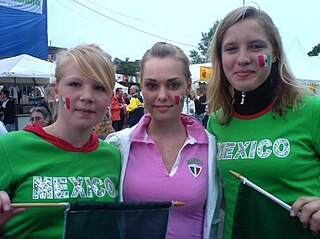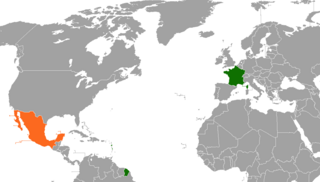
With a population of about 129 million in 2022, Mexico is the 10th most populated country in the world. It is the largest Spanish-speaking country in the world and the third-most populous country in the Americas after the United States and Brazil, the most populous city in the country is the capital, Mexico City, with a population of 9.2 million and its metropolitan area is also the most populated with 21.8 million as of 2020. Approximately 53% of the population lives in one of the 48 large metropolitan areas in the country. In total, about 76% of the population of the country lives in urban areas and 23% lives in rural ones.

The French people are a nation primarily located in Western Europe that share a common French culture, history, and language, identified with the country of France.

The South African diaspora consists of South African emigrants and their descendants living outside South Africa. The largest concentrations of South African emigrants are to be found in the United Kingdom, Australia, the United States and the United Arab Emirates. At the time of the 2021 United Kingdom census, 217,180 residents of England and Wales were born in South Africa. In Australia, there were 189,207 South African-born people living in the country at the moment of the 2021 Census. The 2021 American Community Survey identified 123,461 South African-born residents of the country.

German Mexicans are Mexican citizens of German origin. Most documented ethnic Germans arrived in Mexico during the mid-to-late 19th century and were spurred by government policies of Porfirio Díaz. Many of them took advantage of the liberal policies in Mexico at the time and went into merchant, industrial, and educational ventures. However, others arrived without any or much capital as employees or farmers. Most settled in Mexico City and the surrounding states of Puebla and Veracruz as well as the northern states of Sonora, Sinaloa, Jalisco, and Chihuahua. Later settlers headed south towards the Yucatán Peninsula. Significant numbers of German immigrants also arrived during and after both World Wars. The historic strength of German-Mexican relations has contributed to Mexico having the fourth largest German population in all Latin America behind Brazil, Argentina and Chile.

Immigration to Mexico has been important in shaping the country's demographics. Since the early 16th century, with the arrival of the Spanish, Mexico has received immigrants from Europe, Africa, the Americas, and Asia. Today, millions of their descendants still live in Mexico and can be found working in different professions and industries.

The Romanian diaspora is the ethnically Romanian population outside Romania and Moldova. The concept does not usually include the ethnic Romanians who live as natives in nearby states, chiefly those Romanians who live in Ukraine, Hungary, Serbia, and Bulgaria. Therefore, the number of all Romanians abroad is estimated at 4–12 million people, depending on one's definition of the term "Romanian" as well as the inclusion respectively exclusion of ethnic Romanians living in nearby countries where they are indigenous. The definition of "who is a Romanian?" may range from rigorous conservative estimates based on self-identification and official statistics to estimates that include people of Romanian ancestry born in their respective countries as well as people born to various ethnic-minorities from Romania. As of 2015/16, over 97% of Romanian emigrants resided in OECD countries; and about 90% of Romanian emigrants in OECD countries lived in Europe, with the most common country of residence being Italy. The vast majority of Romanian emigrants are based in just ten countries, with the most common countries being Italy, Germany, Spain, United Kingdom, United States, Hungary, France and Canada.

The Dutch diaspora consists of the Dutch and their descendants living outside the Netherlands.

American Mexicans are Mexicans of full or partial Americans heritage, who are either born in, or descended from migrants from the United States and its territories.

Overseas Pakistanis, or the Pakistani diaspora, refer to Pakistanis who live outside of Pakistan. These include citizens who have migrated to another country as well as people born abroad of Pakistani descent. According to a December 2017 estimate by the Ministry of Overseas Pakistanis and Human Resource Development, approximately 8.8 million Pakistanis live abroad. Data released in 2023 by the Ministry of Emigration and Overseas Employment states that more than 10.80 million people have moved abroad since 1990.

White Mexicans are individuals in Mexico who identify as white, often due to their physical appearance or their recognition of European or West Asian ancestry. The Mexican government conducts ethnic censuses that allow individuals to identify as "White," but the specific results of these censuses are not made public. Instead, the government releases data on the percentage of "light-skinned Mexicans" in the country, with nationwide surveys conducted by the Mexico's National Institute of Statistics and the National Council to Prevent Discrimination reporting results that range from 27% to 47%. The term "Light-skinned Mexican" is preferred by both the government and media to describe individuals in Mexico who possess European physical traits when discussing ethno-racial dynamics. However, "White Mexican" is still used at times.
European emigration is the successive emigration waves from the European continent to other continents. The origins of the various European diasporas can be traced to the people who left the European nation states or stateless ethnic communities on the European continent.

According to a 2022 census, there were 74,122 Mennonites living in Mexico, the vast majority of which are established in the state of Chihuahua, followed by Campeche at around 15,000, with the rest living in smaller colonies in the states of Durango, Tamaulipas, Zacatecas, San Luis Potosí and Quintana Roo.

French Mexicans are Mexican citizens of full or partial French ancestry. French nationals make up the second largest European immigrant group in Mexico, after Spaniards.

The French diaspora consists of French people and their descendants living outside France. Countries with significant numbers of people with French ancestry include Canada and the United States, whose territories were partly colonized by France between the 17th and 19th centuries, as well as Argentina. Although less important than in other European countries, immigration from France to the New World was numerous from the start of the 19th century to the middle of the 20th century. As of 2013, French authorities estimate that between 2 and 3.5 million French nationals are living abroad but the diaspora includes over 30 million people.

Emigration from the United States is the process where citizens and nationals from the United States move to live in countries other than the US, creating an American Diaspora. The process is the reverse of the immigration to the United States. The United States does not keep track of emigration and counts of Americans abroad are thus only available based on statistics kept by the destination countries.

Emigration from Mexico is the movement of people from Mexico to other countries. Immigration from Mexico has risen over the years.
Mexican immigration to Spain refers to the Mexican population in Spain and their Spanish-born descendants. The Mexicans living in Spain are composed primarily of students, skilled professionals, spouses of Spaniards, as well as Mexican citizens who also have Spanish nationality. In December 2008, the National Statistics Institute in Spain had 14,399 registered Mexicans within its territory, of which 7,210 hold other nationalities of the European Union or are family members of EU citizens. To this number must be added those with dual nationality, who are not in Spanish records as foreigners. Mexican and Spanish laws allow dual citizenship, and many Mexicans who have asked for it, whether they are residents in Spain as grandchildren or they are children of Spanish migrants to Mexico. In 2010, the Ministry of Foreign Affairs of Mexico recorded 21,107 Mexicans living in Spain, who became the third largest Mexican community residing abroad, after the United States and Canada; and the largest Mexican community in Europe.

Turks in Mexico comprise Turkish people living in Mexico and their Mexico-born descendants. The Turkish community is largely made up of immigrants or the descendants of immigrants, born in the Ottoman Empire before 1923, in the Republic of Turkey since then or in neighbouring countries once part of the Ottoman Empire that still have some Turkish population.
Latin American migration to Europe is the diaspora of Latin Americans to the continent of Europe, dating back to the first decades of the Spanish and Portuguese empires in the Americas. Latin Americans in Europe are now a rapidly growing group consisting of immigrants from Argentina, Bolivia, Brazil, Chile, Colombia, Costa Rica, Cuba, Dominican Republic, Ecuador, El Salvador, Guatemala, Honduras, Mexico, Nicaragua, Panama, Paraguay, Peru, Puerto Rico, Uruguay and Venezuela. It may also include individuals from certain French-speaking territories depending on the definition of Latin America used.
The Latin American diaspora refers to the dispersion of Latin Americans out of their homelands in Latin America and the communities subsequently established by them across the world.


















